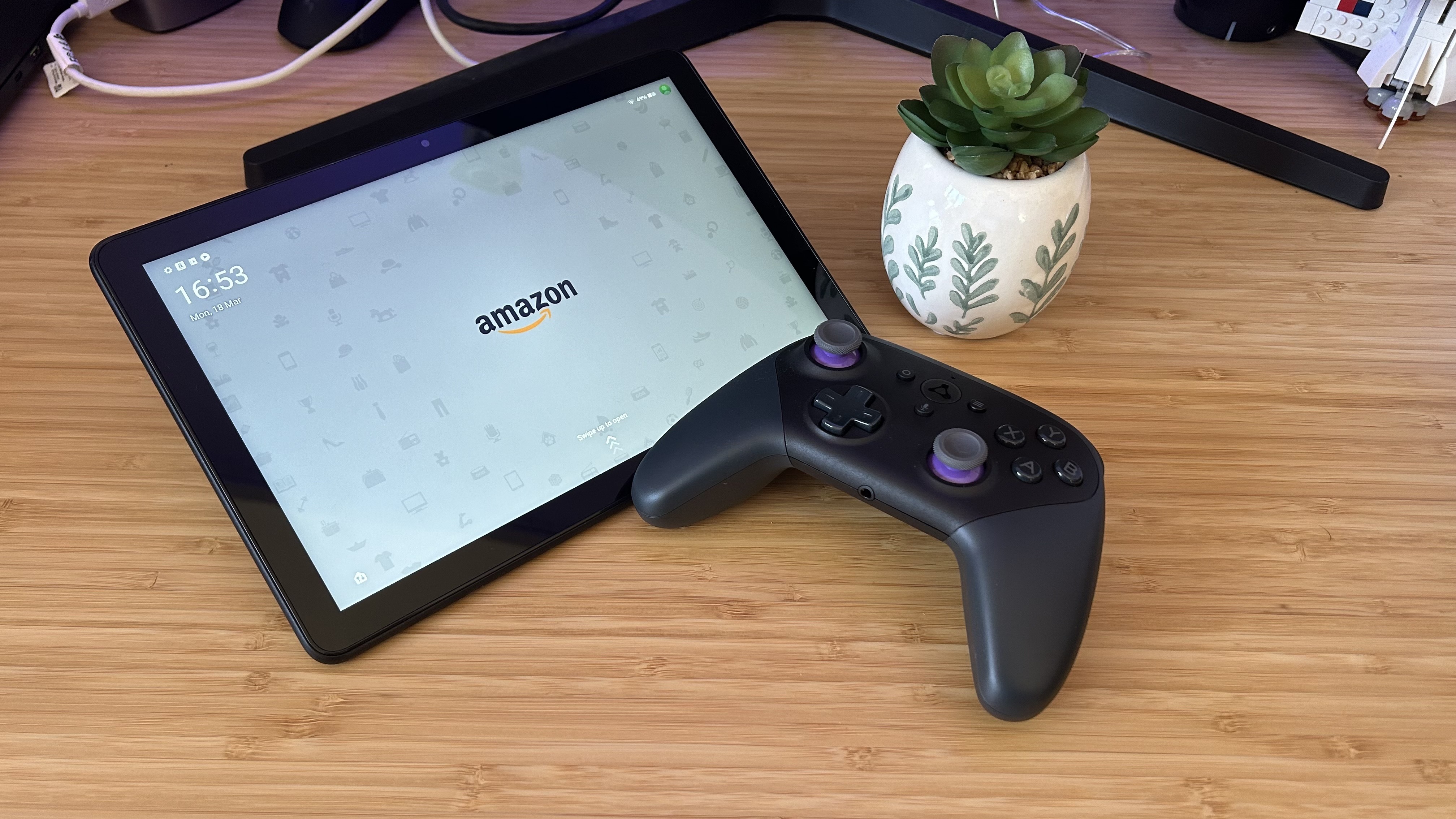GamesRadar+ Verdict
The Amazon Fire HD 10 is a tricky one. At its core, it's a fantastically well-priced tablet busting with value thanks to solid everyday performance, crisp display, and Alexa smart home features. Its reliance on Amazon's own app store is a serious shortcoming, though, putting it out of the hands of productivity users. Gaming is made possible via the Luna service, somewhat redeeming the device at its current price tag.
Pros
- +
One of the cheapest tablets around
- +
Solid, colorful display
- +
Minimal branding
- +
Workable everyday performance
- +
Luna gaming service works well
Cons
- -
Limited to its own Amazon App Store
- -
No Google services
- -
Larger bezels
- -
Cheaper design and feel than competition
Why you can trust GamesRadar+
The Amazon Fire HD 10 has always come in clutch as a budget tablet for those who need a cheap streaming device and are happy to sacrifice functionality by paying a fraction of Apple's prices. It's under $150 / £150, regularly on sale for even less, and offers a 10.1-inch 1080p display with all the movies and TVs you need. The 2023 model lands with a small boost in its processing, improved camera system, lighter form factor, and slight battery jump.
Everything looks good for a barebones system, but with its overreliance on Amazon's own ecosystem, you're stuck if you're looking for a productivity or gaming focused device - though the brand has ways around its own limitations. I spent three weeks with the Fire HD 10 to see just where the 2023 model sits among the best gaming tablets.
| Price | $139.99 / £149.99 |
| Display | 10.1-inch 1920 x 1200 |
| CPU | Octa-Core 2.0GHz |
| RAM | 3GB |
| Storage | 32GB | 64GB |
| Battery | Up to 13 hours |
| Ports | USB-C |
| Camera | 5MP front, 5MP rear |
Design
Available in either black, lilac, or ocean colorways the Amazon Fire HD 10 is an unassuming tablet. Its matte plastic rear is a clear tell that this isn't a high-end Samsung or Apple device, as is the Amazon arrow stamped across the back. In-hand it feels significantly cheaper than its more powerful rivals, with a lightweight design, soft plastic, and chunkier rounded corners. Turning the device on keeps it humble as well, with seriously large bezels surrounding the display itself. Still, that's not uncommon for a budget tablet.
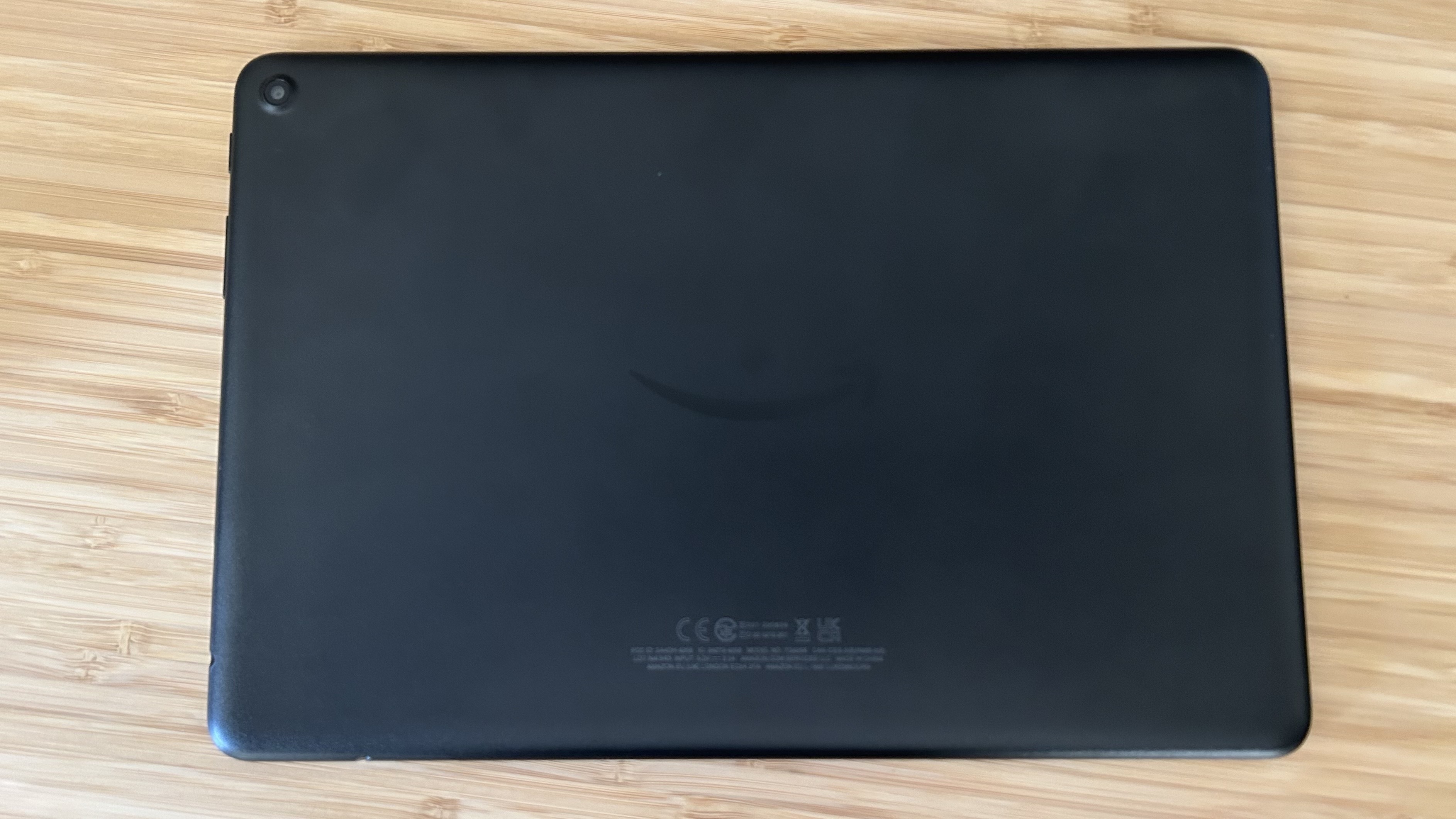
The slightly textured plastic rear surface picks up fingerprints and dust pretty easily, so it's worth slapping a case on it pronto if you don't want to keep wiping it down. Thankfully, Amazon's branding is about as subtle as it can be. The shiny arrow to the rear is easily glossed over, and there are no other brand markings across the entire device.
It doesn't exactly feel breakable, but there's a flex and some creaking to the screen and back panel that can be felt when pushing particularly hard, though this is only noticeable when directly looking for it. I don't expect many users to be putting this level of strain on the device. If you're after something a little more premium, the Amazon Fire HD 11 features a more sophisticated build design with a light gray

Everything is nicely balanced, with a comfortable weight that lends itself well to single handed use. The entire device sits at 439g, making it considerably lighter than the 487g iPad 9th generation but around 100g heavier than the Samsung Galaxy Tab A9.
Features
The Amazon Fire HD 10's 10.1-inch screen runs at a 1920 x 1200 resolution for a crisp, clean finished effect. Colors are represented well, with a nice vibrancy across menus, games, and when streaming more vivid animated scenes. You've got options for adaptive brightness and a blue level scroll for a warmer color profile - particularly handy if you're using your device as an ebook reader in the evening, though I'd still recommend a Kindle above a full-color display like this if that's your sole use-case.
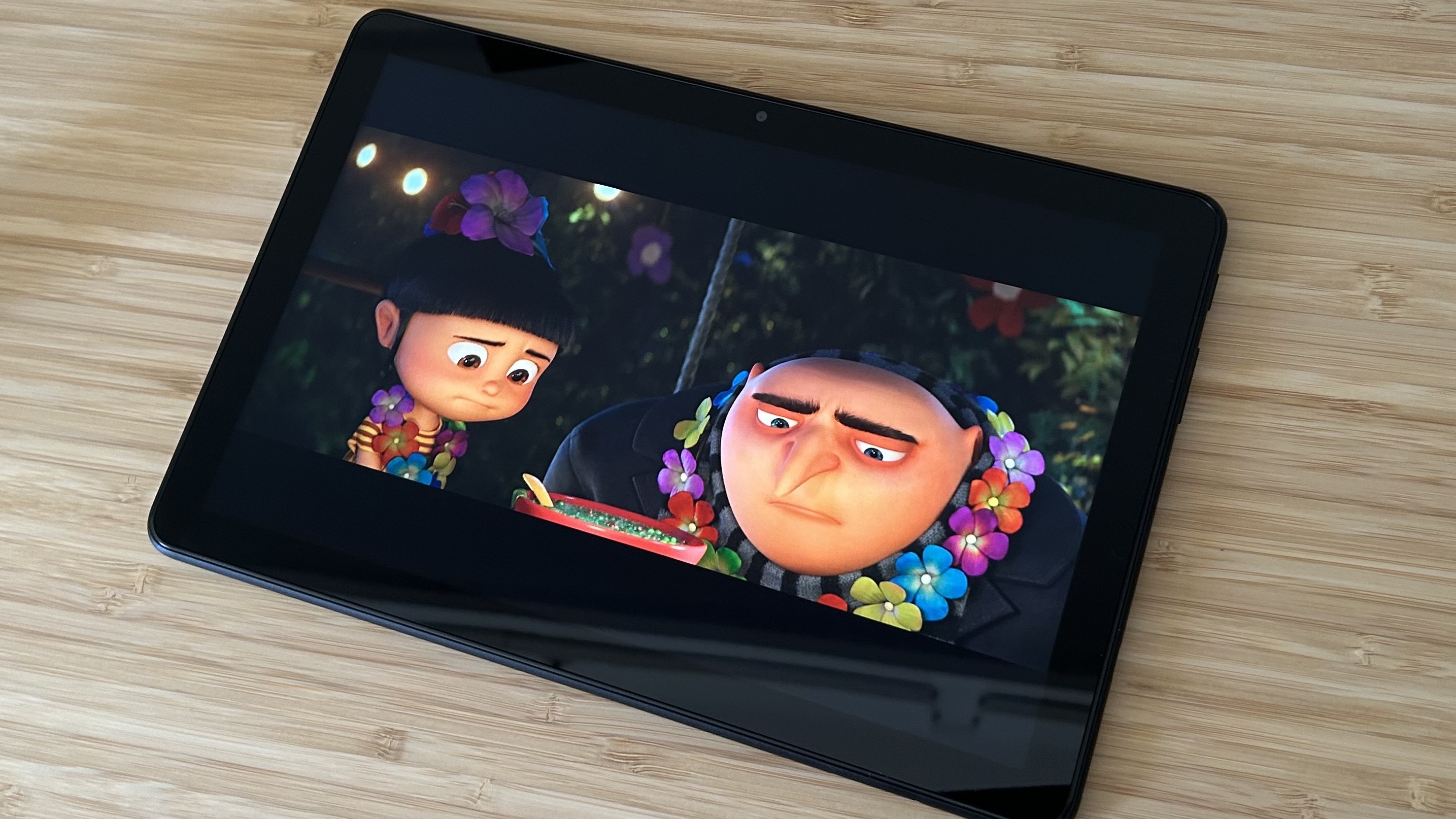
Sound is average, pumping from two speakers set along the top of the device (when held in landscape mode). This isn't going to flaw anyone and if you're primarily listening to music through your device you'll need a separate audio system for finer details and more rounded sound. It's absolutely fine for everyday streaming and casual gaming, though, which is exactly where the Fire HD 10 wants it. Other than that you're set for all the basics, a USB-C charging port is positioned along the right flank (again in landscape mode), next to a 3.5mm audio out. Sharing the same panel is your lock button and volume rocker. WiFi 5 and Bluetooth 5.3 are solid enough for the relaxed use the tablet is designed for. Connection is quick and easy and doesn't falter easily.
Then we come to the real thorn in the Fire HD 10's side, OS. Amazon being Amazon only wants you to run apps from its own selection - there's no Google Play Store and certainly no Google apps. That's a serious limitation if you're using the device for work - you'll instead have to make do with webpage versions of Google's suite via the Silk browser.
Gamers have a few more options, you'll find all the usual thumb tappers on the Appstore, with heavier hitters like Minecraft and Roblox. There are some notable absences here, though, so it's worth making sure your usual roster is available before buying. Overall, though, the Appstore and operating system together lack the flexibility and range of Android, as well as the polish and quality of iPad OS. There's a whole range of games available to download, but they're mostly shovelware.
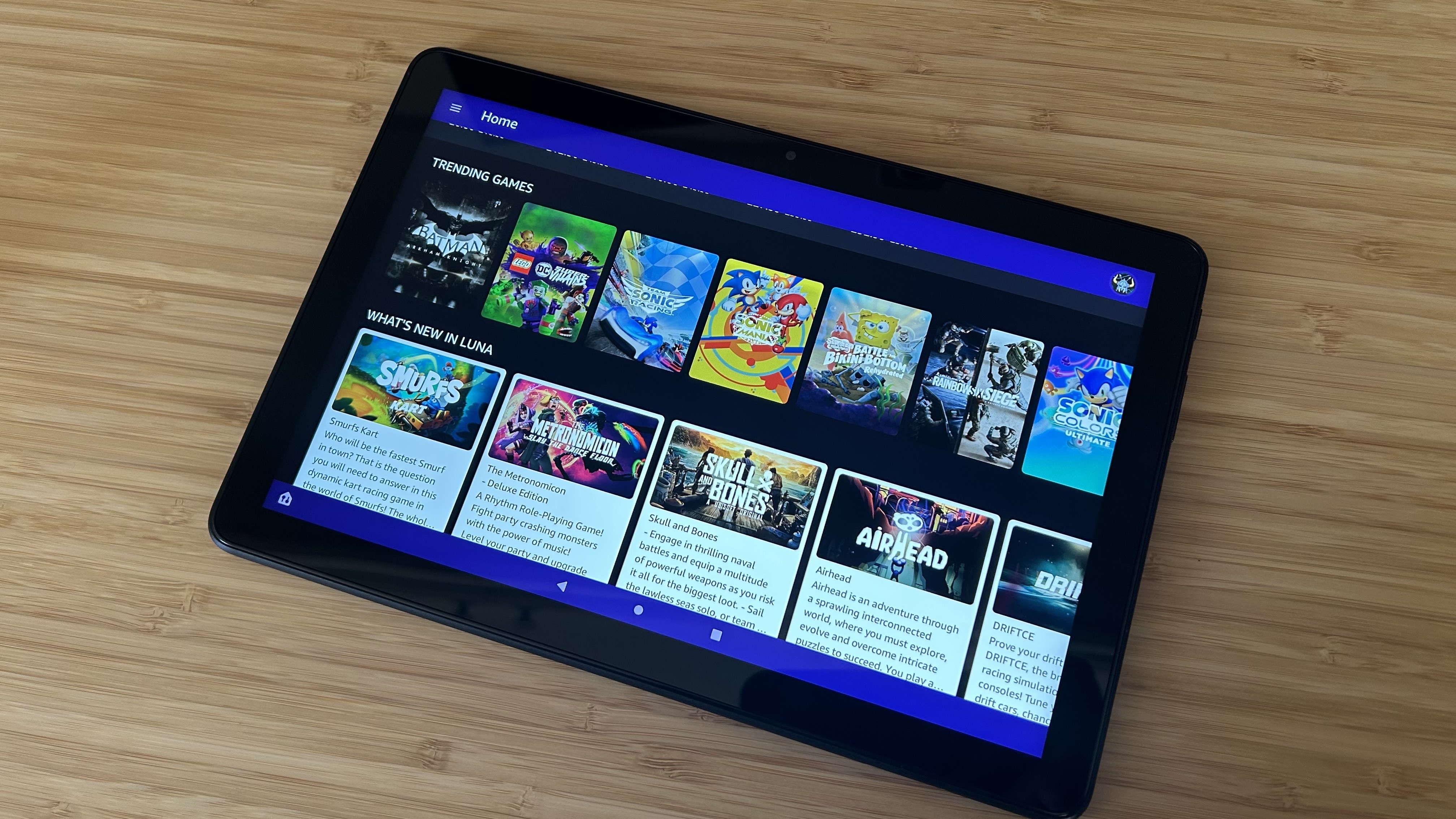
Things get a bit more interesting when you take Amazon Luna into consideration. The retailer's take on game streaming, with its own Luna controller wirelessly connecting direct to the brand's servers. At $9.99 / £8.99 a month it's much cheaper than Xbox Game Pass Ultimate ($16.99 / £12.99 monthly). Xbox has a much larger game library filled with more newer releases, but Luna is a perfectly reasonable budget alternative - especially if you're looking to keep costs down with a cheaper tablet in the first place. Just note that you'll need to pay for bigger titles or stream them via Ubisoft+ for a boosted cost.
Without sideloading anything, there's no way to play Xbox Game Pass Ultimate streamed games on the Fire HD 10.
Performance
Everyday performance is about as good as you're going to get on a sub $150 tablet. Apps load with a zip, and the system can handle split screen between lighter processes just fine. The Silk browser app can't be run twice at the same time in split screen, though, which means productivity can take a hit compared to the browsers available on Android and iPad OS. Still, the 3GB RAM under the hood performs well in this multitasking scenario, though you won't be running any demanding apps side by side. Keeping a wad of apps open in the background didn't lead to stuttering or crashes either.
Gameplay is a little rough and ready. More demanding titles like Minecraft and Roblox take their toll on the system, slowing down more regularly when working through more complex processes and juddering when the screen is filled with just a handful more objects than usual.
Smaller titles perform just as well as they would on pretty much any other device. Yes, loading times are elongated ever so slightly, but your season regulars like Monopoly Go, Clash of Clans, and SimCity Build It zip along nicely here.
Those after something a little meatier will be turning to Amazon Luna, and I was surprised to find that this is actually a pretty low latency system. Running at 1080p, everything was snappy and colorful - from the stark contrasts of Control to the sugar-rush hues of Sonic Mania. Running the Luna Controller via Bluetooth is quick and easy, even if you do need to load up a separate app to get everything connected in the first instance. Yes, there are a few telltale stutters that reminded me I was streaming over a $139.99 tablet, but overall I was impressed with the result. It's not enough to sway me fully away from my Game Pass streaming setup on iPad, but considering you can get up and running with this suite for around $200 it's a substantial offering.
Should you buy the Amazon Fire HD 10?
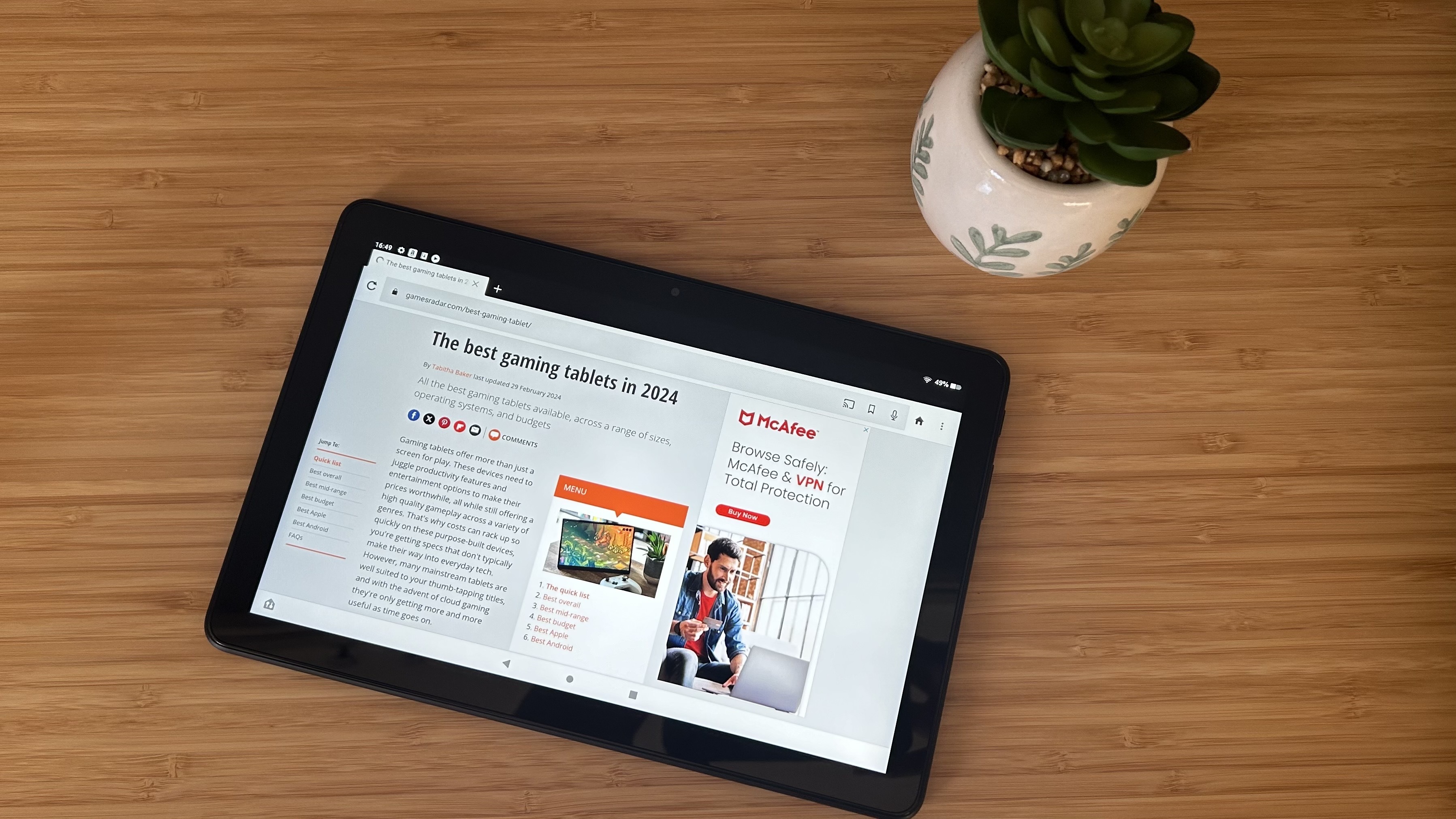
The Amazon Fire HD 10 is only going to make sense for a small subsection of buyers. If you're after a tablet for productivity I would seriously urge you to upgrade to a flagship from either Apple or Samsung. The app stores, operating systems, and available accessories are all far more advanced than those on the Fire HD 10 - and if you catch the right sale you could only be spending around $90 more. If you are looking to spend as little as possible, though, there are other options out there.
There aren't many tablets sitting at under $150, and even fewer found on sale for under $100 / £100. Your decision generally lies between this and the previous generation Samsung Galaxy Tab A8.
The Samsung Galaxy Tab A8 has a higher $229.99 MSRP but is generally found at $150 - $170 on the shelves. It packs a slightly larger 10.5-inch LCD display, with a slimmer bezel design but maintains the Fire HD 10's 1920 x 1200 resolution. It's also built with a slightly more premium finish overall and, crucially, offers the full Google Play Store experience.
At its core, the Fire HD 10 is an extension of Amazon's services - a portal for Prime members to enjoy their content on a dedicated device. If you're already living within this ecosystem you're going to have a solid time here, especially if you're not fussed about productivity or gaming. As a gaming tablet, the Fire HD 10 certainly has its moments. This is pretty much the cheapest option actually worth running in 2024 - allowing you get your hands on some decent titles (and run them well) for $200 with the controller and a month of Luna+ factored into the price point. There aren't many options out there if your budget is this low, but the Amazon Fire HD 10 only makes sense if you're really looking to spend as little as humanly possible.
How we tested the Amazon Fire HD 10
I used the Amazon Fire HD 10, alongside the Amazon Fire HD 11, for three weeks, with one of those weeks dedicated to sole use of the 10-inch model. I used the device for all my streaming and played a few Luna titles across several different play sessions, both using tap gestures on the screen and the Luna Controller. For more information on how we make our recommendations, check out the full GamesRadar+ Hardware Policy.
After something more focused? Check out the best gaming handhelds on the market right now. Or, take a look at the best gaming phones and the best mobile controllers for a smaller screen experience.

Managing Editor of Hardware at GamesRadar+, I originally landed in hardware at our sister site TechRadar before moving over to GamesRadar. In between, I've written for Tom’s Guide, Wireframe, The Indie Game Website and That Video Game Blog, covering everything from the PS5 launch to the Apple Pencil. Now, i'm focused on Nintendo Switch, gaming laptops (and the keyboards, headsets and mice that come with them), PS5, and trying to find the perfect projector.
